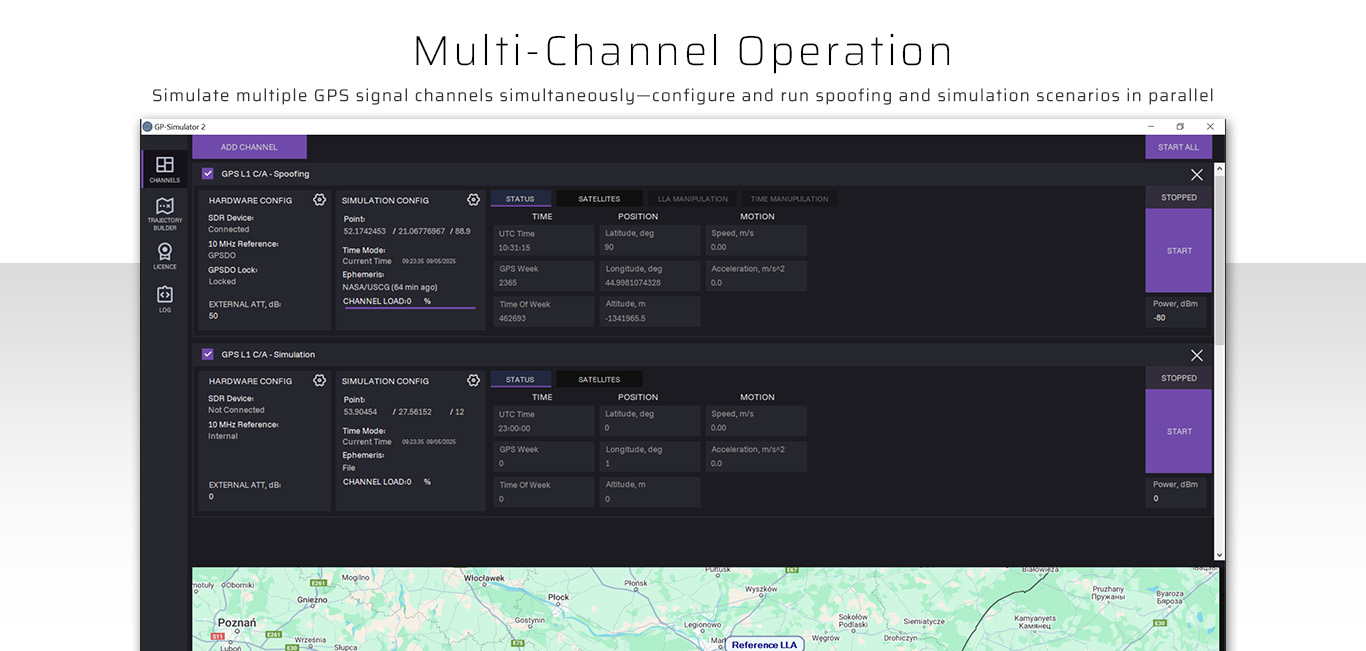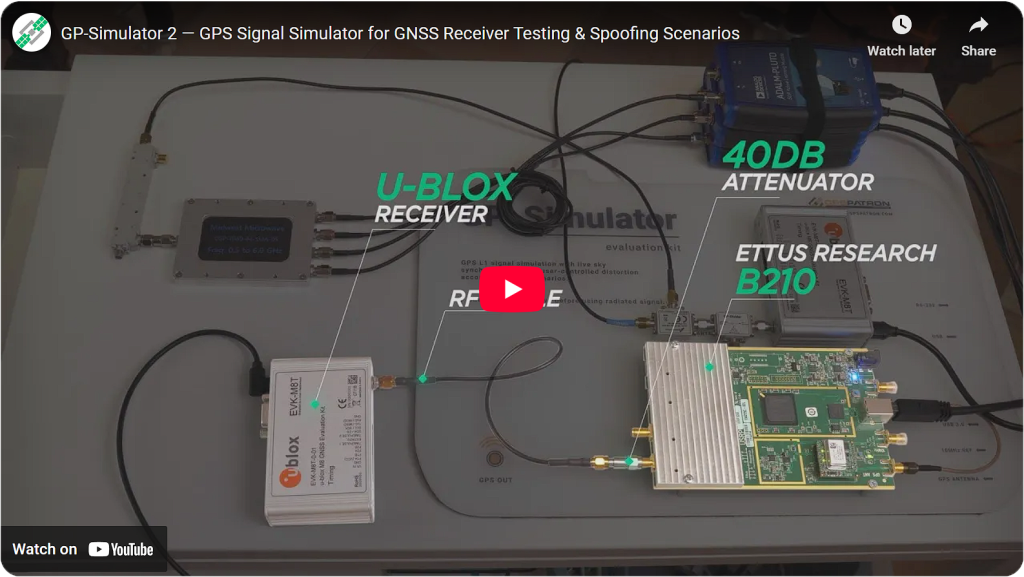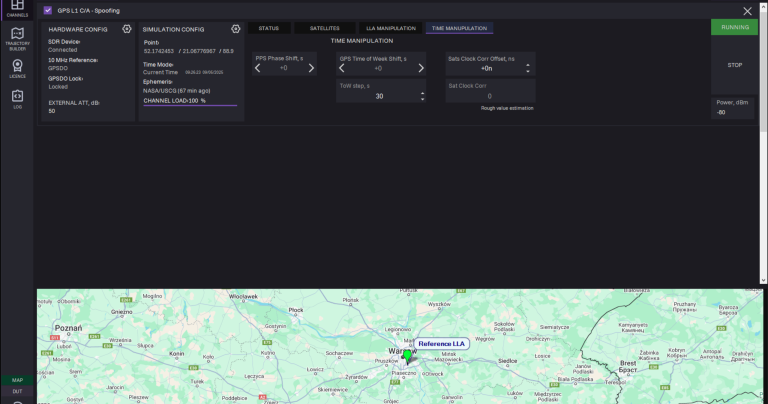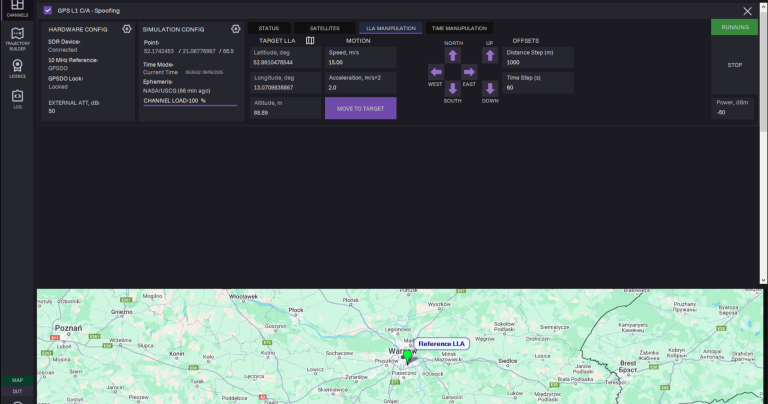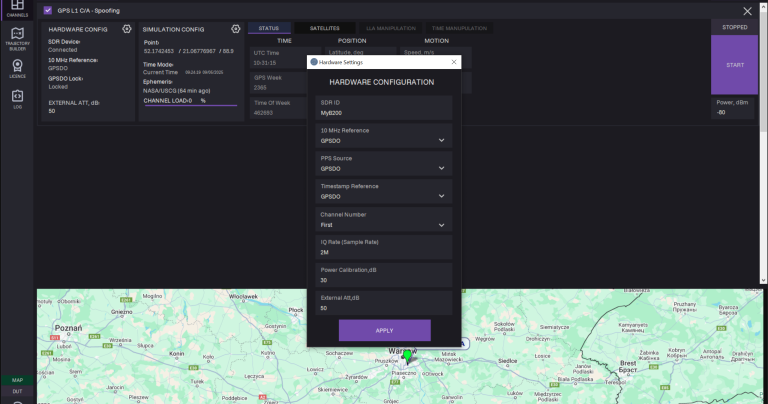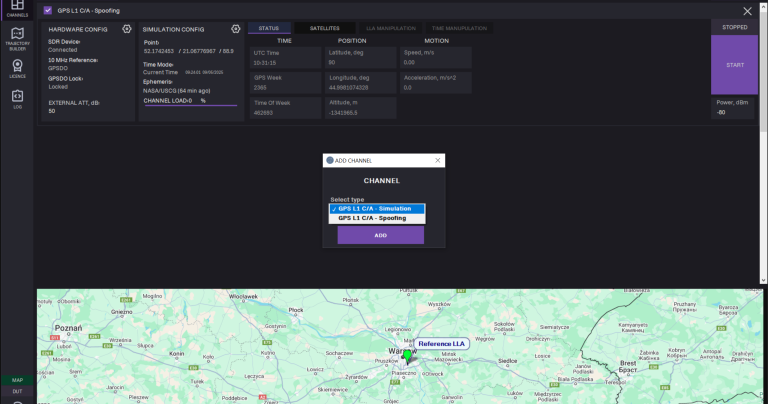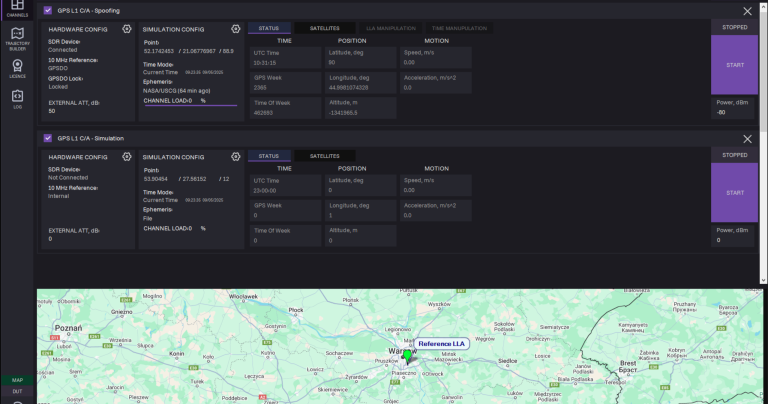Reach out to us for an assessment of your project and to receive a personalized quote tailored to your needs.
GP-Simulator 2
GPS Signal Simulator for Spoofing Vulnerability Assessment and General Purpose Testing
Enables coherent spoofing scenarios for advanced vulnerability testing. Supports a wide range of SDRs
Choose from our trusted distributors to enjoy personalized service, expert advice, and compliance with regional standards for a seamless buying experience.
Key Features
GP-Simulator 2 is a versatile tool for both advanced spoofing research and routine GNSS receiver validation. It’s equally effective for verifying device functionality in lab or production settings and for testing spoofing resilience of time servers, drones, and other GNSS-dependent systems. Whether you’re simulating standard GPS signals or executing precise attack scenarios, the software gives you full control and repeatable results.
Supports Coherent Spoofing
GP-Simulator 2 can generate GNSS signals that are perfectly synchronized with real ones. This allows seamless signal takeovers without loss of tracking, mimicking real-world high-end spoofing attacks.
Advanced Time Manipulation
Modify the receiver’s perception of time in real-time. Features include PPS phase shifting, Time of Week (TOW) manipulation, and simulation of satellite clock errors to test time synchronization robustness.
Live Sky Spoofing
The application allows testing your GNSS receiver using real satellite signals from a live antenna—making it possible to conduct realistic spoofing experiments even in a lab environment.
Position Manipulation
Gain full control over position and altitude. Simulate static offsets or dynamic movement along custom trajectories—ideal for testing drones, vehicles, or high-precision applications.
True Almanac and Ephemeris
The software automatically downloads authentic almanac and ephemeris data from NASA sources, ensuring realistic satellite conditions—even for historical scenarios.
Broad SDR Compatibility
Compatible with Ettus USRP SDRs via UHD drivers. For optimal performance, GP-Simulator 2 also supports GPSPATRON’s custom SDR with enhanced signal stability and timing accuracy. Support for Adalm Pluto and HackRF One is coming soon.
Intro Video
The video demonstrates how to use GP-Simulator 2 for basic GPS signal simulation, showing setup, configuration, and real-time testing of a GNSS receiver. Vulnerability testing of GNSS receivers, time servers, drones, RTK stations, and much more can be found on our YouTube Channel
Use Cases & Applications
GP-Simulator 2 is a powerful GPS simulation and spoofing tool designed for GPS receiver testing in production, R&D, and cybersecurity environments. Below are typical application scenarios where GP-Simulator 2 helps detect vulnerabilities, verify functionality, and improve product quality.
🛡️ Testing GNSS Receivers for Vulnerability to Spoofing and Jamming
Application:
GNSS receivers used in critical applications—such as time synchronization, navigation, asset tracking, and drone control—must be resilient to intentional signal manipulation. With the growing availability of spoofing and jamming technologies, validating the protection mechanisms of GNSS-dependent systems is becoming a crucial step in product development and certification.
How GP-Simulator 2 helps:
GP-Simulator 2 enables precise simulation of GPS L1 spoofing scenarios in a lab or production environment. It supports both coherent and non-coherent spoofing with real-time control over simulated coordinates, time, PPS phase, and satellite parameters. Engineers can test how devices respond to false positioning, time drift, or signal hijacking without the need for outdoor testing or shielded rooms.
To simulate complete GNSS threat environments, GP-Jammer can be added. It allows generation of realistic jamming signals—including wideband, narrowband, and signal-matched interference—across three independent RF channels using Adalm Pluto SDRs. This combination makes it possible to test GNSS receivers under hybrid attack conditions, such as spoofing under jamming pressure, recovery from total signal loss, or simultaneous disruption across multiple constellations.
Together, GP-Simulator 2 and GP-Jammer offer a comprehensive platform for evaluating GNSS receiver robustness, identifying weaknesses, and improving system-level protection. This solution is ideal for manufacturers, integrators, and security professionals working in telecom, energy, transportation, and autonomous systems.
✅ What Problems Does It Solve?
- Verifies GNSS receiver behavior in spoofed or jammed environments
- Detects vulnerabilities to position/time manipulation
- Tests fallback logic and anti-spoofing/jamming algorithms
- Confirms recovery time and performance degradation under threat
- Helps meet security and certification requirements for critical applications
📏 What Can You Measure?
- Receiver reaction to spoofed time and coordinates
- PPS phase drift and sync stability
- Time-to-recovery after jamming or spoofing loss
- Positioning error under hybrid interference
- Alarm triggering and system fallback behavior
- Satellite lock retention and reacquisition time
🎯 Benefits of Using This Setup
- Controlled, repeatable spoofing and jamming scenarios
- No need for GNSS chambers or outdoor testing
- Supports test automation through API
- Multi-channel jamming with flexible waveform configuration
- Coherent spoofing with real-time parameter adjustment
- Scalable from R&D labs to field and production validation
👥 Who Should Use It?
- GNSS receiver and module manufacturers
- Integrators of GNSS-based navigation, timing, and security systems
- Telecom, energy, and transport operators
- Developers of autonomous systems, drones, and critical infrastructure
- Certification labs and compliance teams
⏱ Testing Time Servers and Critical Infrastructure for GNSS Spoofing Vulnerability
Application:
GNSS-disciplined time servers are a cornerstone of modern infrastructure—used in telecommunications, data centers, power grids, financial systems, and transportation networks. Even minor disruptions in time synchronization due to spoofed GNSS signals can lead to cascading failures, service outages, and compliance violations.
How GP-Simulator 2 helps:
GP-Simulator 2 allows you to simulate controlled GPS spoofing attacks—shifting time, PPS phase, and satellite parameters in real time. This makes it possible to evaluate how precisely time servers respond to manipulation, and whether their internal protection algorithms are sufficient.
For complete threat emulation, GP-Jammer can be added to simulate GNSS jamming scenarios. This allows you to assess the combined impact of signal loss and false timing input on mission-critical infrastructure.
✅ What Problems Does It Solve?
- Tests resilience of GNSS-disciplined time servers to spoofing and jamming
- Detects susceptibility to false PPS phase, time drift, and ToW manipulation
- Helps identify synchronization errors under hostile GNSS environments
- Validates fallback behavior and switch to holdover mode
- Ensures regulatory compliance for critical infrastructure timing
📏 What Can You Measure?
- PPS signal phase offset and jitter under spoofed conditions
- Time server reaction time to spoofing or jamming attacks
- Time-to-failover and time-to-recovery metrics
- Accuracy degradation under interference
- Behavior of timing networks under GNSS loss or drift
🎯 Benefits of Using This Setup
- Controlled spoofing and jamming without affecting nearby systems
- Reproducible test scenarios for lab and on-site evaluation
- No need for external test ranges or faraday cages
- Helps meet compliance requirements (e.g., IEC 61850, ITU-T G.8272)
- Supports use in both R&D and operational infrastructure audits
👥 Who Should Use It?
- Operators of telecom, power, and transport networks
- Time server manufacturers and integrators
- GNSS vulnerability auditors and certification labs
- Cybersecurity teams responsible for GNSS-reliant systems
- Government and infrastructure compliance agencies
🔬 Testing and Debugging GNSS Hardware During Product Development
Application:
Electronics developers integrating GNSS modules into their designs (e.g., trackers, drones, IoT, vehicle systems) often need to verify performance and eliminate signal quality issues caused by PCB layout, interference, or component selection.
How GP-Simulator 2 helps:
By generating controlled, repeatable GPS signals directly in the lab, engineers can test GNSS functionality without relying on outdoor conditions or real satellites. This enables fast, precise debugging during schematic and layout development.
✅ Tasks it helps solve:
- Evaluate receiver sensitivity under known signal levels
- Detect impact of on-board EMI from DC/DC converters, microcontrollers, RF circuits
- Test performance with real-time position changes or trajectories
- Verify cold start time and positioning accuracy
- Assess PPS signal precision and stability under varying signal conditions
📏 What you can measure:
- Minimum signal level for stable satellite tracking
- Time-to-first-fix (TTFF) under different scenarios
- Positioning accuracy (static and dynamic)
- Phase offset and jitter of PPS output
- Reaction to simulated signal degradation or distortion
🎯 Key benefits:
- Debug GNSS issues at the engineer’s desk — no outdoor testing required
- Reduce development cycles and avoid costly post-production fixes
- Ensure consistent GNSS performance across prototypes
- Gain confidence in product quality before mass production
👥 Typical users:
- R&D teams at hardware startups and OEMs
- Developers of GNSS-enabled IoT devices
- Engineers working on vehicle electronics, UAVs, asset trackers
📦 Batch Testing of GPS Modules Before Assembly
Application:
Electronics manufacturers who purchase GNSS modules from third-party suppliers need to ensure that every module meets performance and reliability standards before soldering it onto the main PCB. Quality issues such as counterfeit, ESD damage, or degraded sensitivity are common — and costly if detected too late.
How GP-Simulator 2 helps:
By simulating stable GPS signals in a controlled lab setup, GP-Simulator 2 allows manufacturers to quickly test large batches of GNSS modules under identical, repeatable conditions. This can be done either manually or as part of an automated test station using the API module.
✅ Tasks it helps solve:
- Validate module functionality before PCB mounting
- Measure signal acquisition time and sensitivity
- Identify defective, underperforming, or fake GNSS modules
- Compare modules from different suppliers
- Automate quality checks as part of incoming inspection or pre-assembly stage
📏 What you can measure:
- Cold start performance
- Number of satellites acquired and average SNR
- Time-to-first-fix under controlled signal levels
- Module PPS output presence and stability
- Stability of coordinates in static mode
🎯 Key benefits:
- Prevent defective GNSS modules from entering your production line
- Reduce rework, scrapping, and warranty claims
- Gain traceability and performance statistics for each module or supplier
- Save time by running high-volume, fast GNSS verification indoors
- Improve overall product quality and reduce manufacturing risk
👥 Typical users:
- EMS (Electronics Manufacturing Services) companies
- OEMs assembling GNSS-based products
- QA departments responsible for inbound component validation
✅ Final Testing of Assembled Devices with Integrated GNSS Modules
Application:
After assembling GNSS-enabled products — such as vehicle trackers, telematics units, wearable devices, IoT sensors, or navigation systems — manufacturers need to confirm that the built-in GNSS module functions correctly in its final hardware and firmware configuration.
How GP-Simulator 2 helps:
GP-Simulator 2 allows production teams to simulate stable, repeatable GPS signals in a controlled indoor environment. Devices under test (DUTs) can be evaluated for GNSS performance without needing sky access or test driving. The same test scenario can be replayed across thousands of units with consistent results.
✅ Tasks it helps solve:
- Verify GNSS module integration and firmware configuration
- Ensure correct PPS output behavior
- Confirm fix acquisition and coordinate accuracy
- Perform trajectory-based testing for mobile use cases
- Detect intermittent faults that may not show up in static bench tests
📏 What you can measure:
- Time-to-first-fix (cold and hot starts)
- Accuracy of reported coordinates in static or dynamic simulation
- PPS signal timing and stability
- Sensitivity and signal lock robustness under marginal conditions
- Functional validation of antenna, RF front-end, and GNSS stack
🎯 Key benefits:
- Eliminate dependency on GPS antennas or open-sky testing
- Perform GNSS validation inside test chambers or assembly lines
- Standardize GNSS testing across production batches
- Catch firmware bugs or hardware integration issues before shipment
- Enable pass/fail logic and logging for QA automation
👥 Typical users:
- Manufacturers of GPS-enabled devices
- Automotive electronics providers
- IoT hardware developers
- QA and end-of-line testing teams
Licensing & Bundles
Explore available software licenses, hardware kits, and ready-to-use bundles tailored for GNSS simulation and spoofing.
🔑 Licenses
Permanent software licenses that activate core simulation functionality.
GP-Simulator 2 – Core | GPS Simulation
SKU: GPS2/CORE/PER
Permanent software license for GNSS signal simulation. Ideal for testing GPS receivers in laboratory or production environments. Supports simulation of up to 12 GPS L1 satellites.
🧩 Software Options (Add-ons)
Optional modules that extend functionality with spoofing, dual-channel operation, or automation capabilities.
GP-Simulator 2 opt.: GPS Spoofing
SKU: GPS2/Opt/SPOOF/PER
Adds spoofing functionality to the core software. Enables coherent spoofing and real-time manipulation of position and time during signal generation. Recommended for cybersecurity, research, and spoofing resilience testing.
GP-Simulator 2 opt.: Two-Channels
SKU: GPS2/Opt/2CH/PER
Adds support for dual-channel signal generation. Simulate a legitimate signal and spoofed signal in parallel, or spoof two independent targets. Useful for advanced and comparative testing scenarios.
GP-Simulator 2 opt.: API Control
SKU: GPS2/Opt/API/PER
Enables API access for automation and integration. Ideal for automated test environments, scripting, and integration into CI systems or external platforms.
🛠️ Hardware Kits
High-performance SDR kits bundled with essential RF accessories in a rugged case — ready for lab or field use.
GP-Simulator 2 – SDR Kit
SKU: GPS2/SDR/KIT
High-performance SDR unit optimized for use with GP-Simulator 2. Supplied in a rugged case with all essential RF accessories (cables, attenuators, DC blockers, adapters, etc.) for quick setup in lab or field conditions.
📦 Pre-Configured Bundles
Save with ready-to-use combinations of software and hardware — ideal for simulation, spoofing, or GNSS threat emulation.
GP-Simulator 2 – Basic Simulation Bundle
SKU: GPS2/BUNDLE/BASE
A complete starter kit for GPS signal simulation. Ideal for receiver validation, QA, or integration testing. Includes software, SDR, laptop, and RF accessories — all packaged in a rugged portable case.
Includes:
- GP-Simulator 2 – Core License
- GP-Simulator 2 – SDR
- High-performance laptop (Ryzen 7, 32 GB RAM, RTX 4060)
- Rugged case – NANUK 923 Laptop, Black
- Full set of RF accessories required for quick and trouble-free setup
GP-Simulator 2 – Spoofing Bundle
SKU: GPS2/BUNDLE/SPOOF
A complete spoofing test kit including the core simulator, spoofing extension, and SDR hardware. Designed for GNSS vulnerability testing in labs, research, and development environments. Includes software, SDR, laptop, and RF accessories in a rugged portable case.
Includes:
- GP-Simulator 2 – Core License
- GP-Simulator 2 opt.: GPS Spoofing
- GP-Simulator 2 – SDR
- High-performance laptop (Ryzen 7, 32 GB RAM, RTX 4060)
- Rugged case – NANUK 923 Laptop, Black
- Full set of RF accessories required for quick and trouble-free setup
GP-Simulator 2 – Advanced GNSS Threat Simulation Bundle
SKU: GPS2/BUNDLE/THREAT
A comprehensive kit for advanced GNSS spoofing and jamming testing. Combines GP-Simulator and GP-Jammer platforms with all required hardware for evaluating GNSS vulnerabilities of time servers, drones, and critical infrastructure. Includes software, SDRs, high-performance laptop, and RF accessories in a rugged portable case.
Includes:
- GP-Simulator 2 – Core License
- GP-Simulator 2 opt.: GPS Spoofing
- GP-Simulator 2 – SDR
- GP-Jammer 3-Channel License
- 3× Adalm Pluto SDR
- High-performance laptop (Ryzen 7, 32 GB RAM, RTX 4060)
- Rugged case – NANUK 923 Laptop, Black
- Full set of RF accessories required for quick and trouble-free setup
Application Specification
Supported Signals
- GPS L1 C/A
- GPS L2, L5, and Galileo E1B/C is coming soon
Supported SDR Devices
- Ettus USRP
Full support via UHD drivers. Compatible with B200, B210, X310, and other models. Synchronization via GPSDO.
Supports coherent spoofing simulation scenarios. - GP-Simulator SDR – Proprietary high-performance SDR with low phase noise, enhanced frequency stability, and precise timing synchronization. Offers improved spoofing fidelity and signal clarity. Supports coherent spoofing simulation scenarios.
- Adalm Pluto (coming soon) – Supports basic signal generation. Doesn’t support coherent spoofing.
- HackRF One (coming soon) – Supports basic signal generation. Doesn’t support coherent spoofing.
Supported Operating Systems
- Windows 11 (64-bit)
- Windows 10 (64-bit)
- Windows 8 (64-bit)
Minimum System Requirements
- Intel® Core™ i3 Processors
- RAM 8 GB
- Free hard drive space 1-GB
- One port USB 3.0
- Internet (optional)
Simulation Modes
- Signal Simulation
Standard GPS signal simulation for receiver testing. Set a static point, time, or dynamic trajectory, control output power, and adjust per-satellite signal strength during runtime. - Spoofing Simulation
Enables coherent and non-coherent spoofing. During signal generation, allows real-time manipulation of time and position to test spoofing resilience.
Multi-Channel Signal Generation
Simulate multiple GPS channels simultaneously. Enables complex scenarios such as dual spoofing attacks or combining a reference (legitimate) signal on one channel with a spoofed signal on another.
Position Simulation Modes
- Fixed Location
Manually specify static latitude, longitude, and altitude. - Trajectory Simulation
Move the simulated receiver dynamically along a user-defined path
Trajectory Builder
Built-in graphical editor for creating and editing movement paths. Supports:
- Waypoint-based vector format
- Speed and Acceleration assignment per segment
Time Simulation Modes
- Current Time
Simulate GNSS signals based on real-time system clock. - Past Time
Reproduce historical satellite configurations and timing conditions. - Future Time
Predict and simulate GNSS signals for a future date with synthetic ephemeris.
Almanac and Ephemeris Sources
- Local Files
Load RINEX almanac and ephemeris files from disk. - Synthetic Data
Use generated orbital parameters for testing without real data. - Automatic Download
Fetch authentic NASA data (via CDDIS or USCG) for the selected simulation time range.
Almanac source: www.navcen.uscg.gov
Ephemeris source: ftp://cddis.nasa.gov
Timing & Synchronization
Enables precise alignment of simulated GPS signals through configurable timing sources.
Includes the following options:
- 10 MHz Reference – Select clock source:
- Internal oscillator
- External 10 MHz reference
- GPS-disciplined oscillator (GPSDO)
- PPS Source – Select pulse-per-second synchronization input:
- Internal (free-run)
- External (trigger)
- GPSDO
- Timestamp Reference – Select timebase for GPS data alignment:
- Local system clock (PC)
- NTP Server
- GPSDO
Power Control
- Power control during signal generation.
- SDR output power calibration.
- Compensation for external RF signal path losses.
Spoofing Simulation
| Spoofing Type: |
|
| Time Manipulation: |
|
| Position Manipulation: |
|
Support
| Support: | 1 year of complimentary technical support |
| Manuals: | Online quick start guide |
GP-Simulator SDR Specification
RF Front-End
AD9363, 2×2 MIMO
Frequency Range
325 MHz – 3.8 GHz
RF Bandwidth
up to 20 MHz
ADC / DAC
12-bit, 61.44 MS/s
Max TX Power
- Up to 10 dBm CW (frequency dependent)
- Up to 0 dBm for GPS signal
Power Control Dynamic Range
80 dB
Power Regulation Step
0.5 dB
Baseband Chipset
Xilinx Artix-7 XC7A100T, 512 MB DDR3 RAM
Connectivity
USB 3.0 Type-C
Timing & Synchronization
- Embedded GPSDO
- Embedded 50 ppb TCXO
- 10 MHz Reference input/output
- Trigger/PPS Reference input
GPSDO Performance
- Live sky synchronization time accuracy: ± 250 ns to UTC RMS (2-Sigma)
- GPSDO 10 MHz Accuracy: 1 ppb
Data Stream Bandwidth
Up to 56 MSPS real-time (USB 3.0 host)
Mechanical
| Enclosure: | Anodized aluminum |
| Size: | 115 × 80 × 35 mm |
| Weight: | ~500 g |
Environmental
| Operational Temperature: | 0°C to +50°C |
| Storage Temperature: | -20°C ~ +80°C |
| Humidity: | 0% – 90% RH non-condensing @ 40°C |
Regulatory Compliance
Complies with the requirements: CE | FCC | ROHS
| EMC: | EN 55032 FCC Part 15B |
| Safety: | EN 62368-1 |
Warranty & Support
| Warranty: | 1 year Extended warranty is available |
| Support: | 1 year of complimentary technical support |
Package Content
| GP-Simulator SDR: | 1 pc. Main signal generation unit with USB-C interface and GPSDO support. |
| Rugged Carrying Case: | 1 pc. IP-rated protective case for transport and on-site testing |
| USB Type-C Cable: | 1 pc. High-quality shielded cable for SDR connection to host computer. 1 meter. |
| SMA Attenuators: | 3 pcs. Fixed-value attenuators: 10 dB, 20 dB, and 40 dB for signal level control |
| Directional Coupler: | 1 pc. For signal injection into GNSS antenna port of the receiver under test for live spoofing testing. |
| 4-Way RF Combiner: | 1 pc. Used with 3-channel GP-Jammer to combine spoofing and jamming signals to test multi-band GNSS receiver. |
| RF Cables: | 3 pcs. SMA-Male to SMA-Male 30 cm. RF cables for connecting components. |
| GP-Divider: | Passive RF splitter for using a single GNSS antenna with two receivers. |
| Manuals: |
Online quick start guide |
